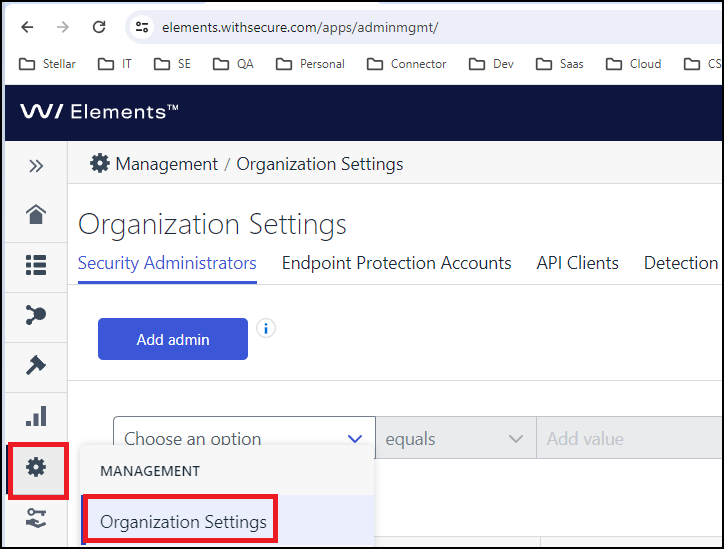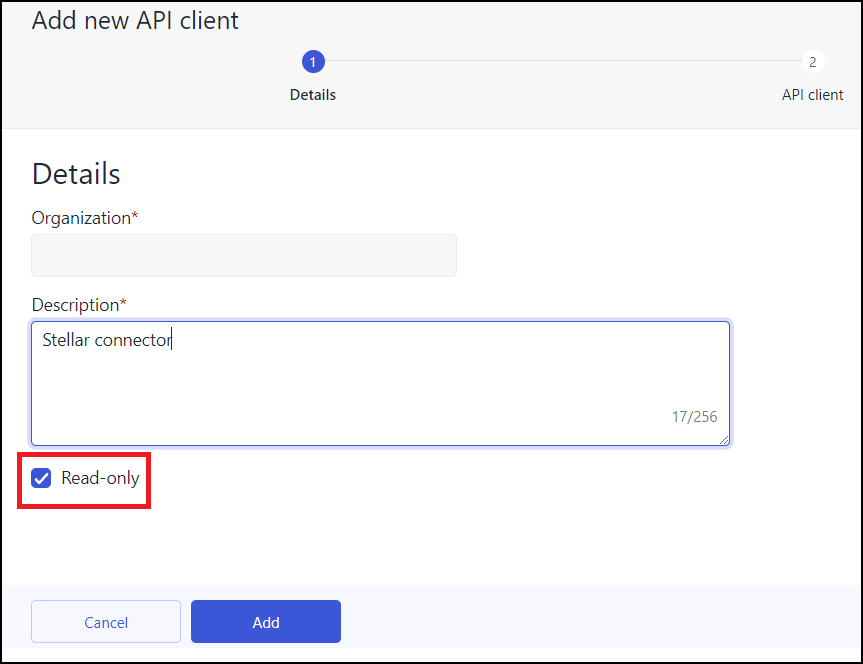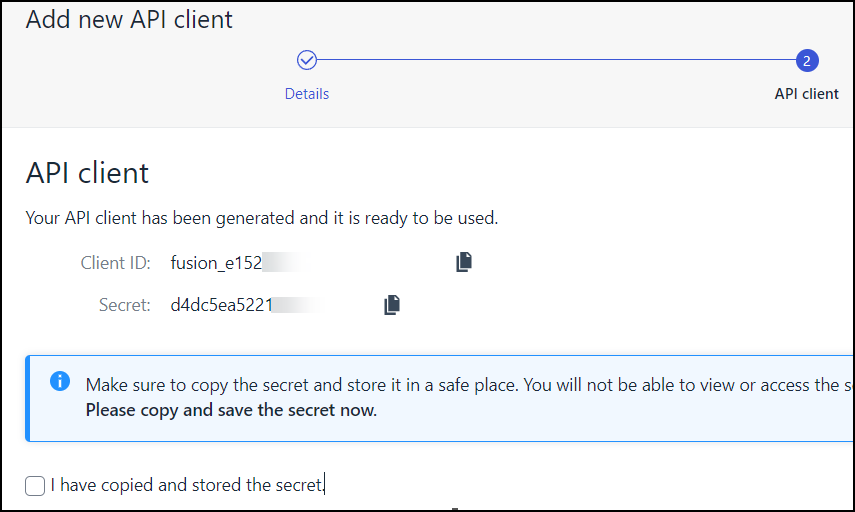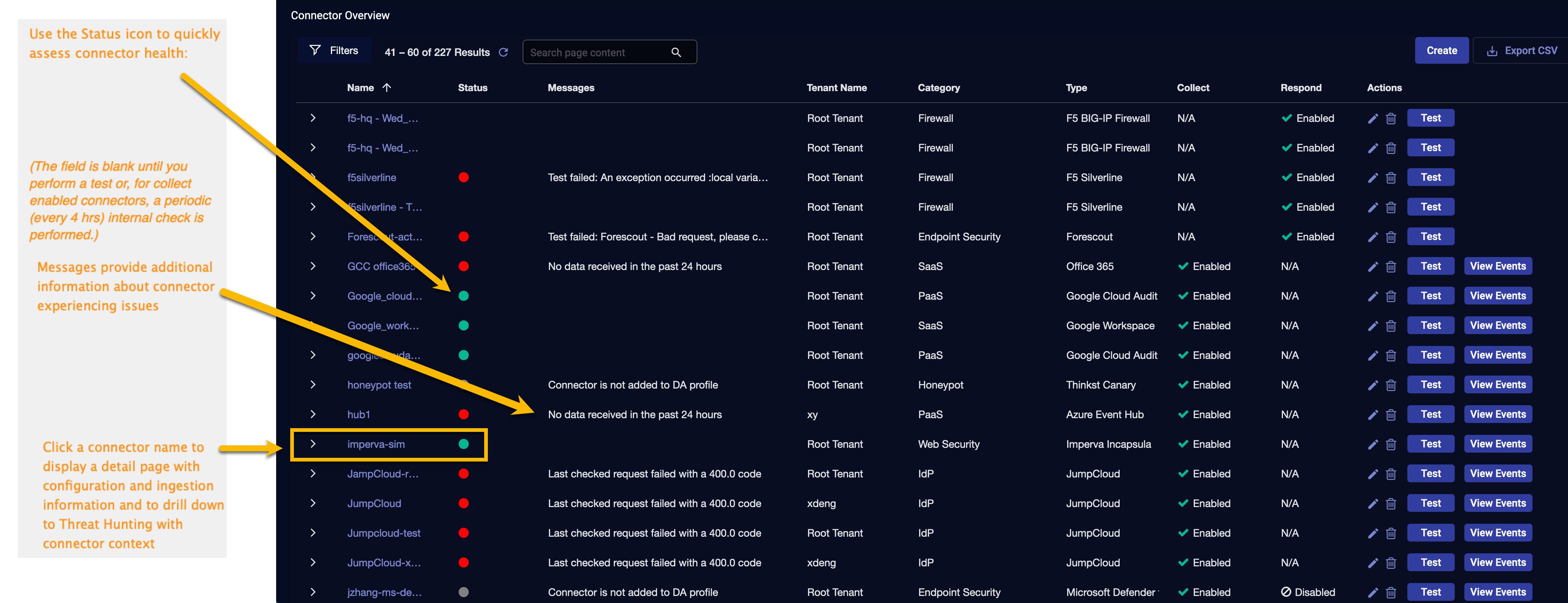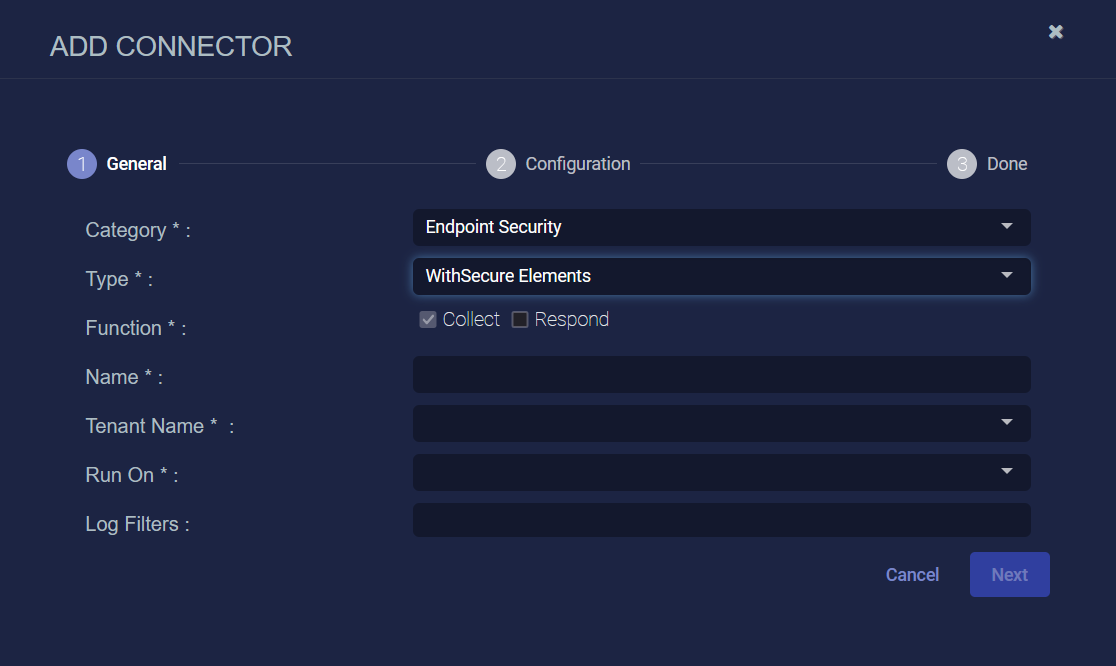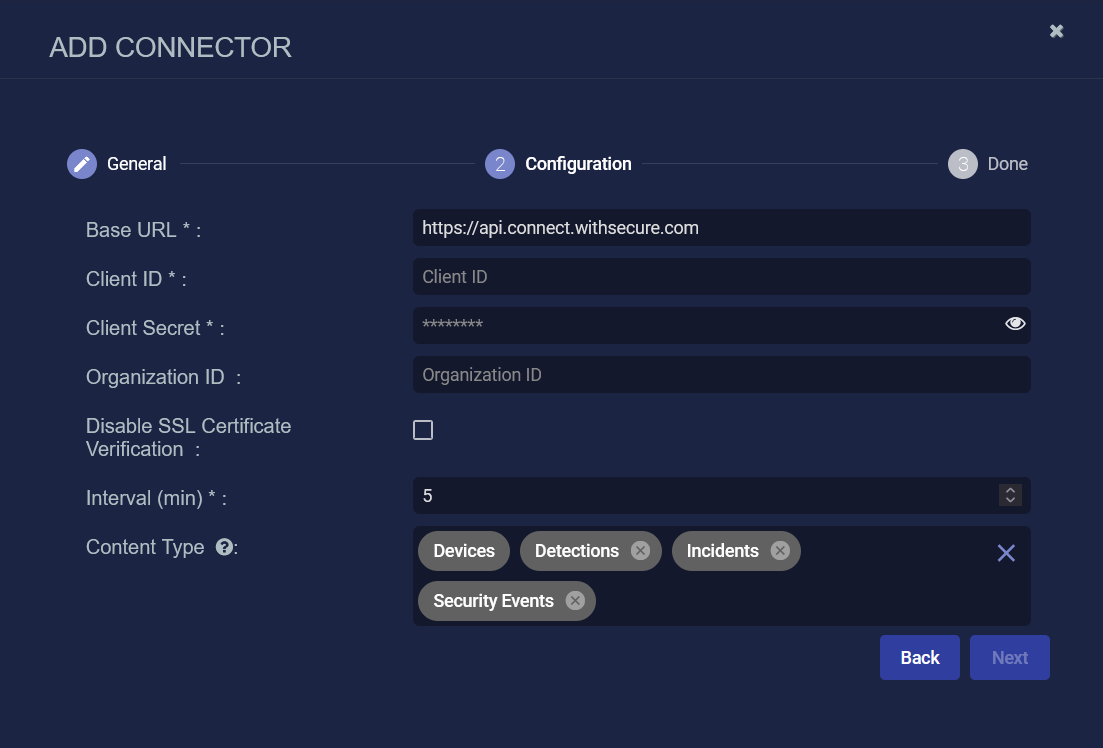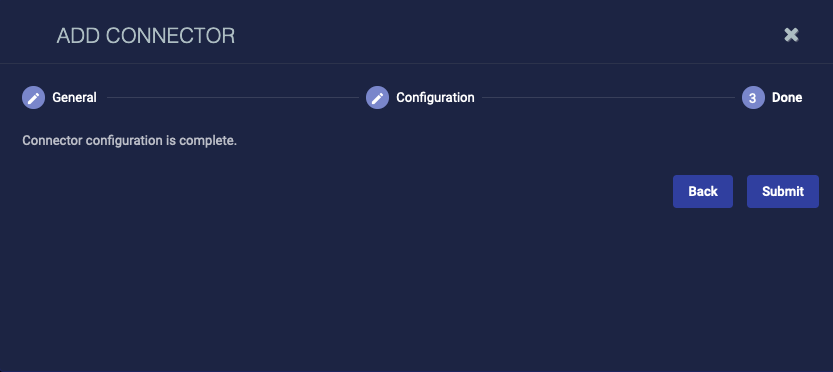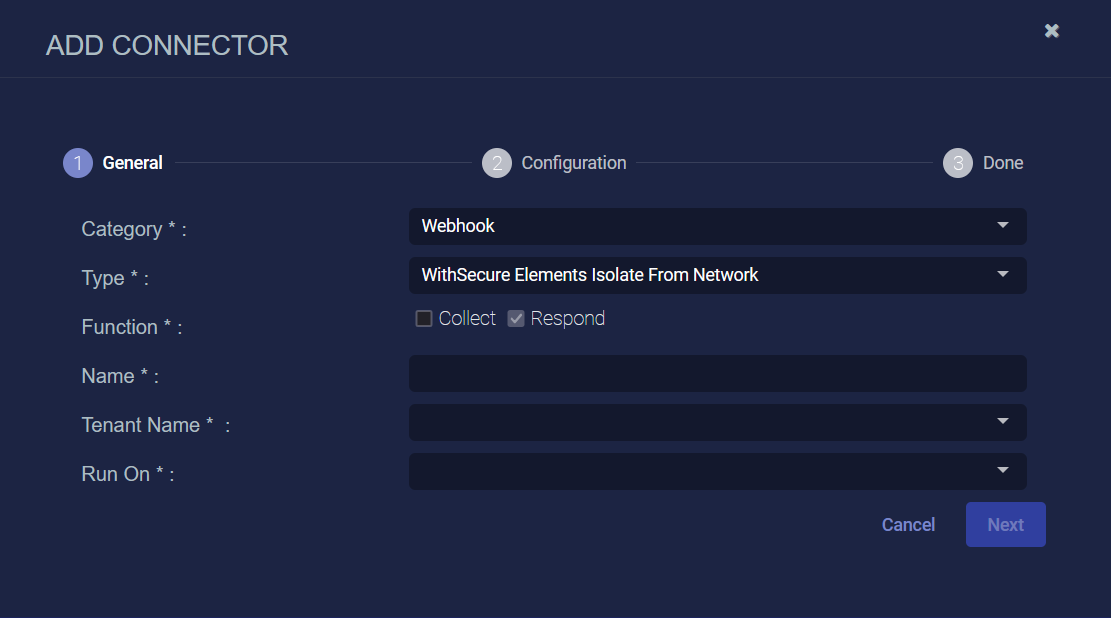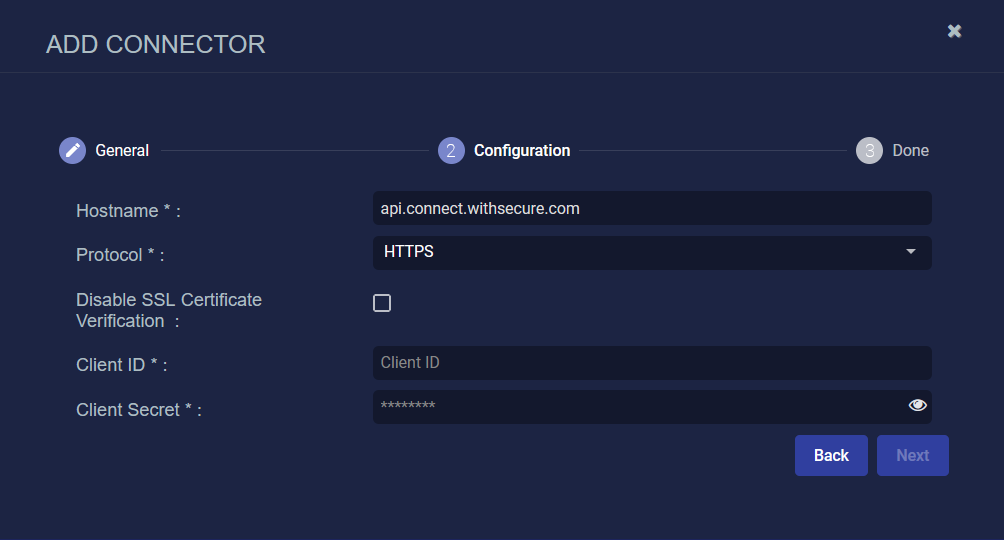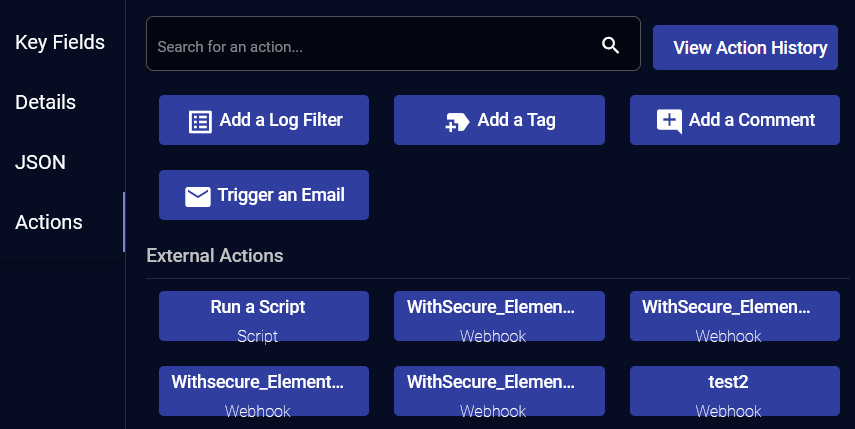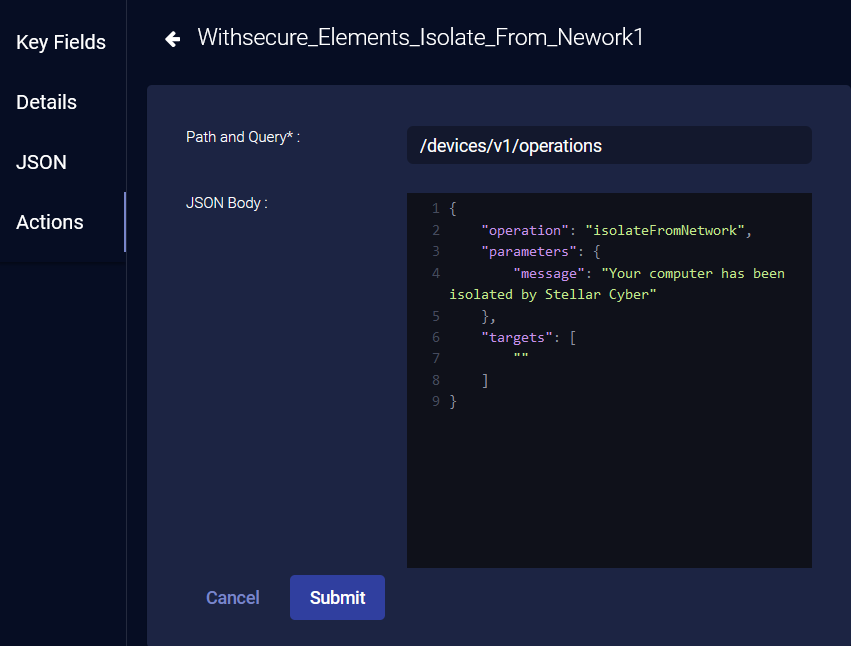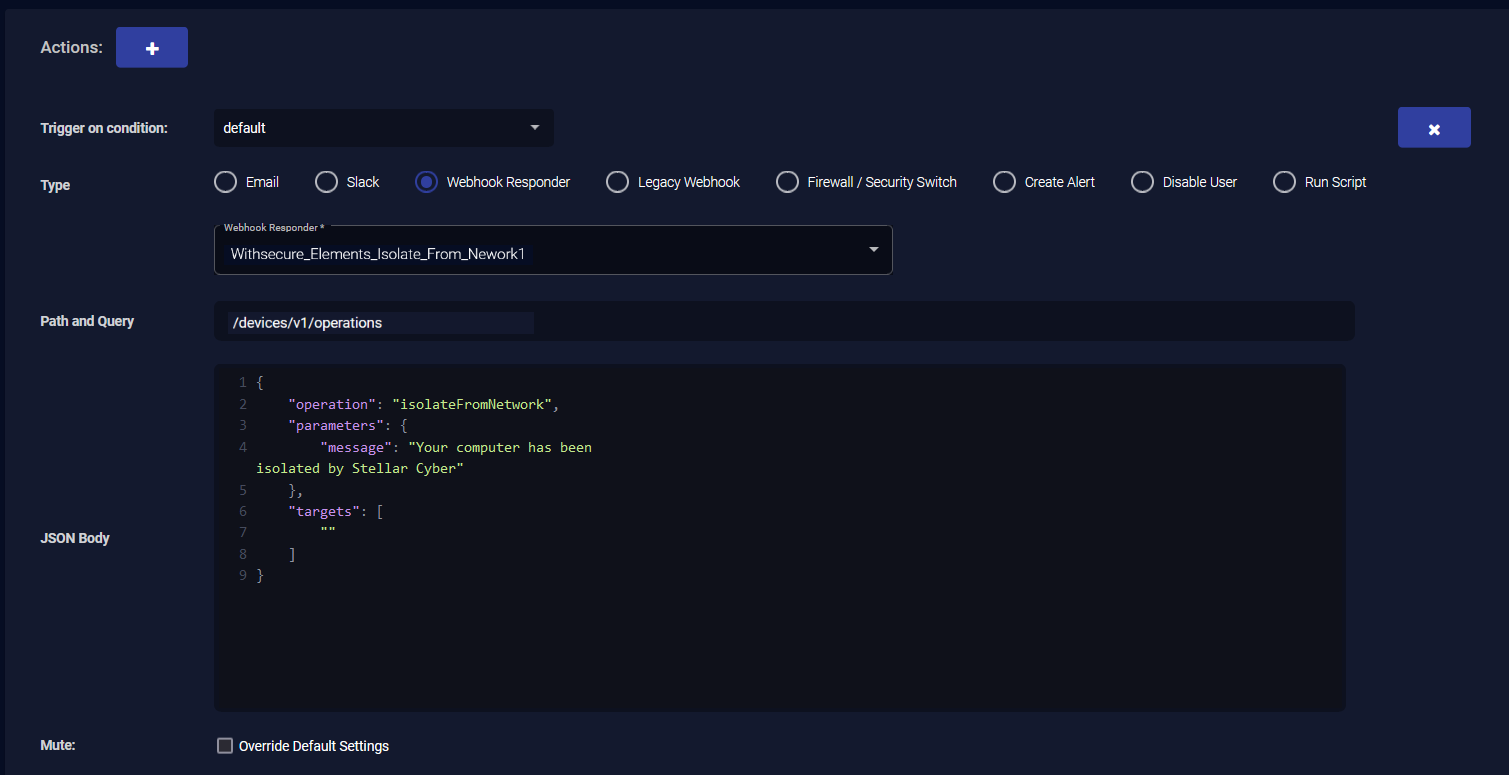Configuring WithSecure Elements Connectors
This connector allows Stellar Cyber to ingest logs from WithSecure Elements and add the records to the data lake. This connector integrates with the WithSecure Elements API to query devices, events, incidents, and detections.
In addition, you can use WithSecure Elements responders to configure Webhook actions that can be triggered manually or that can enhance Automated Threat Hunting (ATH) actions.
WithSecure Elements responders use Webhook templates that support actions. Each action is one responder, there are four actions, and hence there are four WithSecure Elements responders: WithSecure Elements Isolate From Network, WithSecure Elements Kill Process, WithSecure Elements Kill Thread, and WithSecure Elements Release From Network Isolation.
This document describes how to configure a WithSecure Elements responder using the Universal Webhook Responder, how to add the respond function to a WithSecure Elements connector and how to manually trigger an action and perform ATH actions with a WithSecure Elements responder.
Stellar Cyber connectors with the Collect function (collectors) may skip collecting some data when the ingestion volume is large, which potentially can lead to data loss. This can happen when the processing capacity of the collector is exceeded.
Connector Overview: WithSecure Elements
Capabilities
-
Collect: Yes
-
Respond: Yes
-
Native Alerts Mapped: No
-
Runs on: DP
-
Interval: Configurable
Collected Data
|
Content Type |
Index |
Locating Records |
|---|---|---|
|
Detections Devices Incidents Security Events |
Syslog Assets (for Devices) |
Domain
|
<Base URL> where <Base URL> is a variable from the configuration of this connector |
Response Actions
Webhook action templates:
-
WithSecure Elements Isolate from Network
-
WithSecure Elements Kill Process (Beta feature)
-
WithSecure Elements Kill Thread (Beta feature)
-
WithSecure Elements Release From Network Isolation
Third Party Native Alert Integration Details
N/A
Required Credentials and Configurations
-
Base URL, Client ID, Client Secret, and Organization ID
Adding a WithSecure Elements Connector
To add a WithSecure Elements connector:
- Obtain credentials
- Add the connector in Stellar Cyber (Collect)
- Add the connector in Stellar Cyber (Respond)
- Test the connector
- Verify ingestion
- Use actions
Obtaining WithSecure Elements Credentials
Before you configure the connector in Stellar Cyber, you must obtain the following WithSecure Elements credentials:
-
Base URL—URL for connect function. The default is: https://api.connect.withsecure.com
-
Hostname—Hostname for respond function. The default is: api.connect.withsecure.com
-
Client ID and Client Secret—Generated API Client ID and Secret
Generating a Client ID and Client Secret
To generate a Client ID and Client Secret:
-
Log in to the Console.
-
Navigate to Management > Organization Settings.
-
Select the API Clients tab and click Add new.
-
On the Add new API client page, enter an Organization and a Description.
-
For an API key for the Collect function, check Read-only.
-
For an API key for the Respond function, uncheck Read-only.
-
-
Click Add.
-
The API client is generated. Copy the Client ID and Secret. You will need them when configuring the connector in Stellar Cyber.
Store the Client ID and Secret in a safe location. It cannot be retrieved later although you can create a new one.
Adding the Connector in Stellar Cyber (Collect)
To add the collect function for a WithSecure Elements connector in Stellar Cyber:
-
Log in to Stellar Cyber.
-
Click System | Connectors (under Integrations). The Connector Overview appears.
-
Click Create. The General tab of the Add Connector screen appears. The information on this tab cannot be changed after you add the connector.
The asterisk (*) indicates a required field.
-
Choose Endpoint Security from the Category drop-down.
-
Choose WithSecure Elements from the Type drop-down.
-
For this connector, the supported Function is Collect, which is enabled already.
-
Enter a Name.
Notes:- This field does not accept multibyte characters.
- It is recommended that you follow a naming convention such as tenantname-connectortype.
-
Choose a Tenant Name. The Interflow records created by this connector include this tenant name.
-
Choose the device on which to run the connector.
-
(Optional) When the Function is Collect, you can apply Log Filters. For information, see Managing Log Filters.
-
Click Next. The Configuration tab appears.
The asterisk (*) indicates a required field.
-
Enter the Base URL you noted above in Obtaining WithSecure Elements Credentials.
-
Enter the Client ID you noted above.
-
Enter the Client Secret you noted above.
-
(Optional) Enter the Organization ID.
If an Organization ID is not entered, the default organization of the authenticated client is used.
-
(Optional) Click Disable SSL Certificate Verification if you want to disable SSL certificate verification. Only disable SSL certificates if you have a reason to, otherwise, it is not a good security practice.
-
Choose the Interval (min). This is how often the logs are collected.
The logs for Devices are queried every 24 hours.
-
Choose the Content Type you would like to collect. The logs for Detections, Devices, Incidents, and Security Events are supported.
The Devices content type is always selected and cannot be removed from the configuration as it is required for host information.
-
Click Next. The final confirmation tab appears.
-
Click Submit.
The new connector is immediately active.
Adding the Connector in Stellar Cyber (Respond)
To add the respond function for a WithSecure Elements connector in Stellar Cyber:
-
Log in to Stellar Cyber.
-
Click System | Connectors (under Integrations). The Connector Overview appears.
-
Click Create. The General tab of the Add Connector screen appears. The information on this tab cannot be changed after you add the connector.
The asterisk (*) indicates a required field.
-
Choose Webhook from the Category drop-down.
-
Choose one of the predefined templates from the Type drop-down: WithSecure Elements Isolate From Network, WithSecure Elements Kill Process, WithSecure Elements Kill Thread, or WithSecure Elements Release From Network Isolation.
WithSecure Elements Kill Process and WithSecure Elements Kill Thread are Beta features.
-
For this connector, the supported Function is Respond, which is enabled already.
-
Enter a Name.
Notes:- This field does not accept multibyte characters.
- It is recommended that you follow a naming convention such as tenantname-connectortype.
-
Choose a Tenant Name. This identifies which tenant is allowed to use the connector. In addition to specific tenants, this connector supports All Tenants, which means that a WithSecure Elements responder can be used across tenants.
-
Choose the device on which to run the connector.
-
Certain connectors can be run on either a Sensor or a Data Processor. The available devices are displayed in the Run On menu. If you want to associate your collector with a sensor, you must have configured that sensor prior to configuring the connector or you will not be able to select it during initial configuration.
-
If the device you're connecting to is on premises, we recommend you run on the local sensor. If you're connecting to a cloud service, we recommend you run on the DP.
-
-
Click Next. The Configuration tab appears.
The asterisk (*) indicates a required field.
-
Enter the Hostname you noted above in Obtaining WithSecure Elements Credentials.
-
Select the Protocol, either HTTP or HTTPS. If you select HTTPS, another field is available: Disable SSL Certificate Verification.
-
(Optional) Click Disable SSL Certificate Verification if you want to disable SSL certificate verification. Only disable SSL certificates if you have a reason to, otherwise, it is not a good security practice.
-
Enter the Client ID and Client Secret you noted above.
-
Click Next. The final confirmation tab, Done, appears.
-
Click Submit.
Testing the Connector
When you add (or edit) a connector, we recommend that you run a test to validate the connectivity parameters you entered. (The test validates authentication and connectivity).
For connectors running on a sensor, Stellar Cyber recommends that you allow 30-60 seconds for new or modified configuration details to be propagated to the sensor before performing a test.
-
Click System | Connectors (under Integrations). The Connector Overview appears.
-
Locate the connector by name that you added, or modified, or that you want to test.
-
Click Test at the right side of that row. The test runs immediately.
Note that you may run only one test at a time.
Stellar Cyber conducts a basic connectivity test for the connector and reports a success or failure result. A successful test indicates that you entered all of the connector information correctly.
To aid troubleshooting your connector, the dialog remains open until you explicitly close it by using the X button. If the test fails, you can select the button from the same row to review and correct issues.
The connector status is updated every five (5) minutes. A successful test clears the connector status, but if issues persist, the status reverts to failed after a minute.
Repeat the test as needed.
If the test fails, the common HTTP status error codes are as follows:
| HTTP Error Code | HTTP Standard Error Name | Explanation | Recommendation |
|---|---|---|---|
| 400 | Bad Request | This error occurs when there is an error in the connector configuration. |
Did you configure the connector correctly? |
| 401 | Unauthorized |
This error occurs when an authentication credential is invalid or when a user does not have sufficient privileges to access a specific API. |
Did you enter your credentials correctly? Are your credentials expired? Are your credentials entitled or licensed for that specific resource? |
| 403 | Forbidden | This error occurs when the permission or scope is not correct in a valid credential. |
Did you enter your credentials correctly? Do you have the required role or permissions for that credential? |
| 404 | Not Found | This error occurs when a URL path does not resolve to an entity. | Did you enter your API URL correctly? |
| 429 | Too Many Requests |
This error occurs when the API server receives too much traffic or if a user’s license or entitlement quota is exceeded. |
The server or user license/quota will eventually recover. The connector will periodically retry the query. If this occurs unexpectedly or too often, work with your API provider to investigate the server limits, user licensing, or quotas. |
For a full list of codes, refer to HTTP response status codes.
Verifying Ingestion
To verify ingestion:
-
Click Investigate | Threat Hunting. The Interflow Search tab appears.
-
Change the Indices for the type of content you collected:
-
For Devices, Detections, Incidents, and Security Events, change the Indices to Syslog.
-
For Devices only, change the Indices to Assets.
The table immediately updates to show ingested Interflow records.
-
Manually Triggering an Action
To manually trigger an action with a WithSecure Elements responder:
-
Click Investigate | Threat Hunting. The Interflow Search tab appears.
-
Change the Indices for the record type, for example, Syslog.
-
Scroll down the page and click the icon for More Info in the Actions column.
-
Click the Actions tab. Webhook actions appear under External Actions.
-
Click a WithSecure Elements Webhook action. The template populates the fields in the Path and Query and the JSON Body.
-
You can modify the JSON Body by entering string values or curly brace expressions. Fill in any empty fields, such as organizationId, threadId, or targets.
-
To perform the action, click Submit.
Performing an ATH Action
To perform an ATH action with a WithSecure Elements responder:
-
Click Respond | Automation.
-
Click Create.
-
Scroll down to Actions.
-
Click the button to add an action. Another action appears below the existing action.
-
Select the Trigger on condition.
-
Select Webhook Responder for the Type.
-
Select a previously configured WithSecure Elements responder from the drop-down menu for the Webhook Responder. The template populates the fields in the Path and Query and JSON Body.
-
You can modify the JSON Body by entering string values or curly brace expressions.
-
(Optional) Click Override Default Settings to override the playbook's mute settings and mute just this action.
-
Click Submit.
